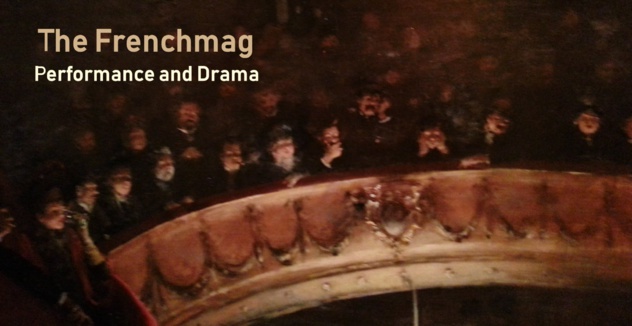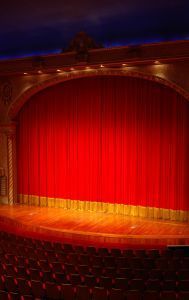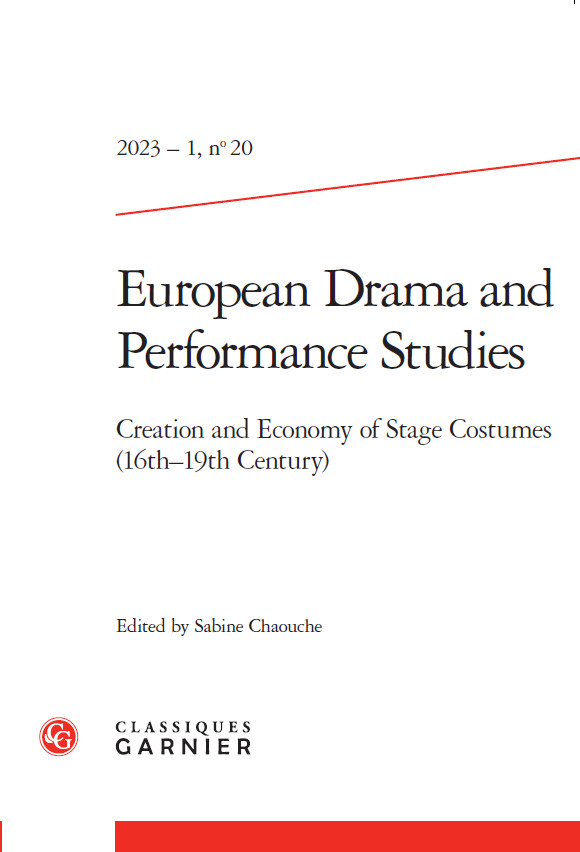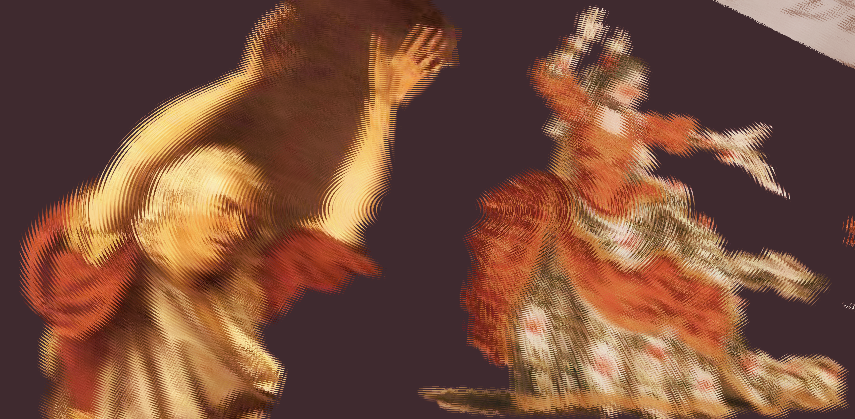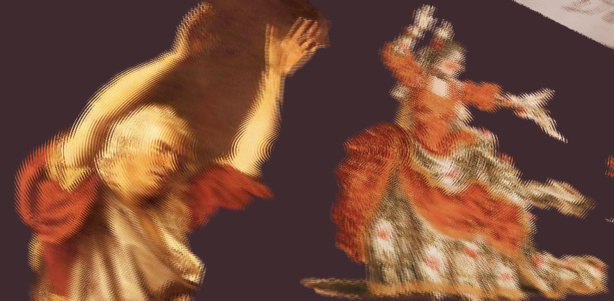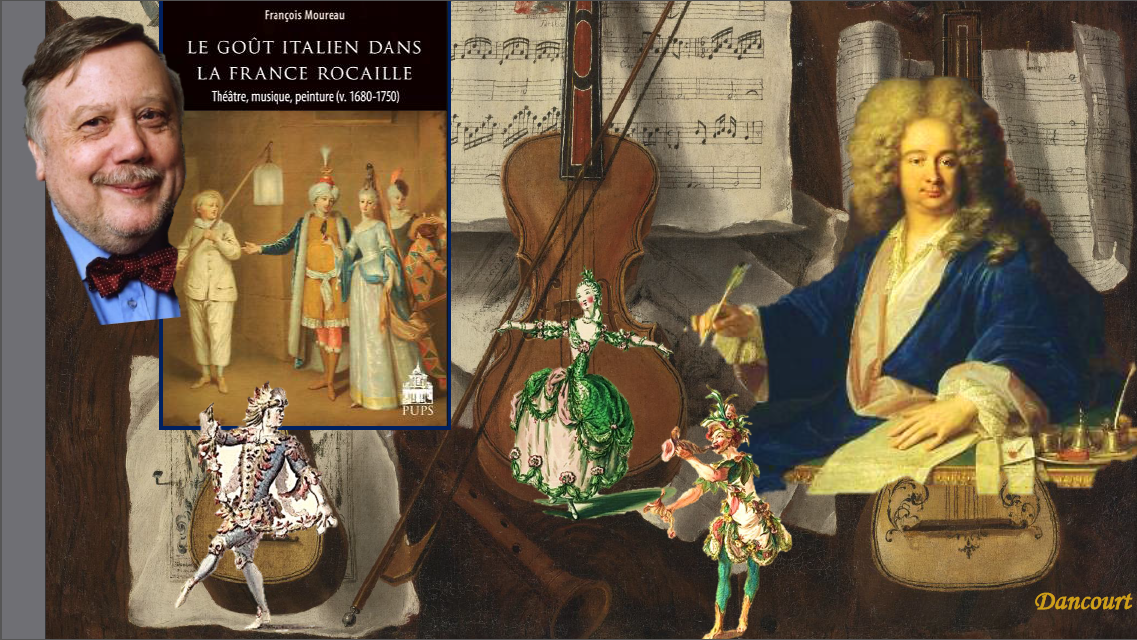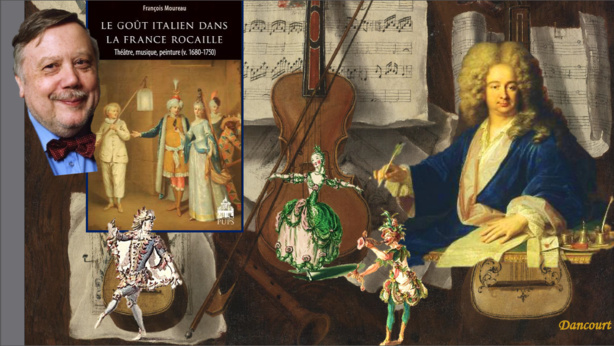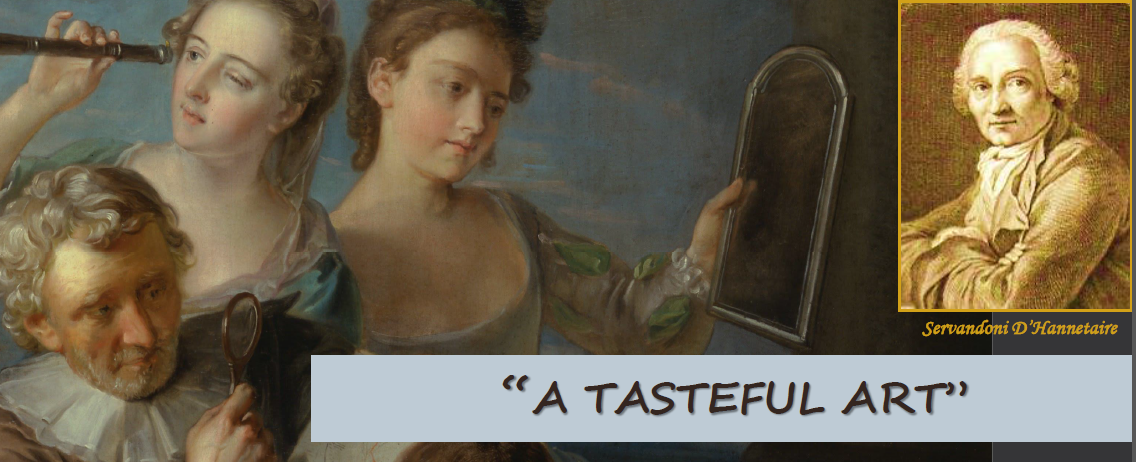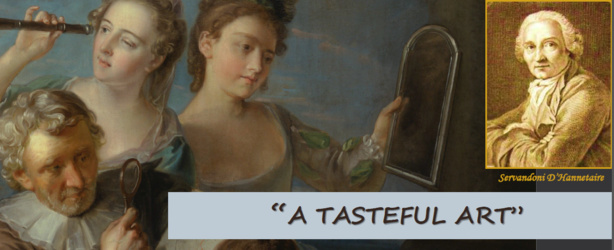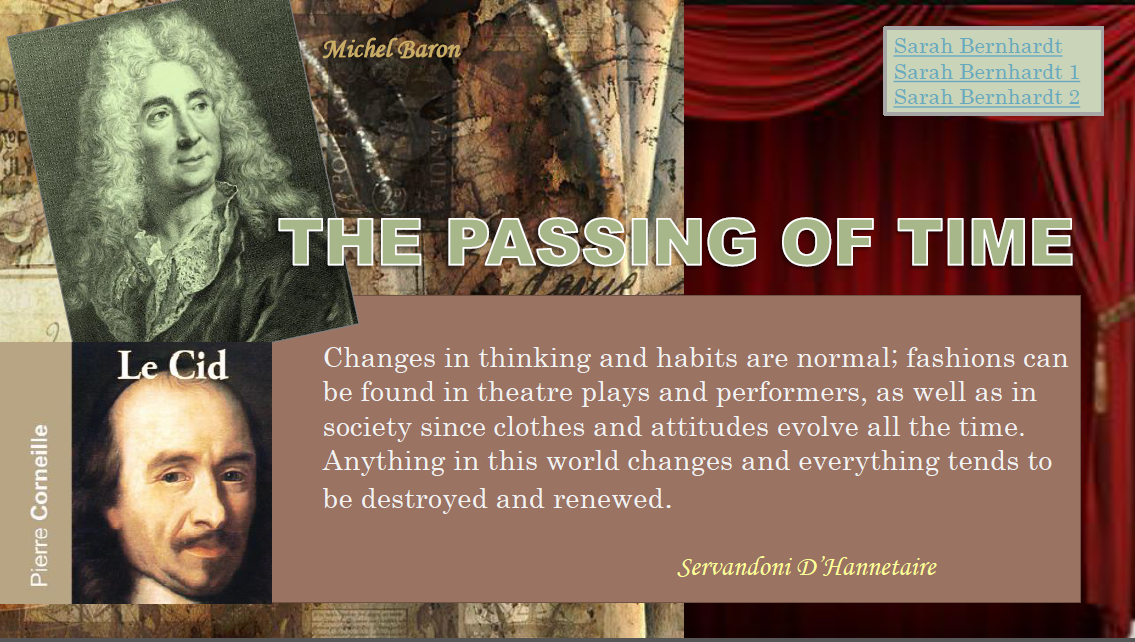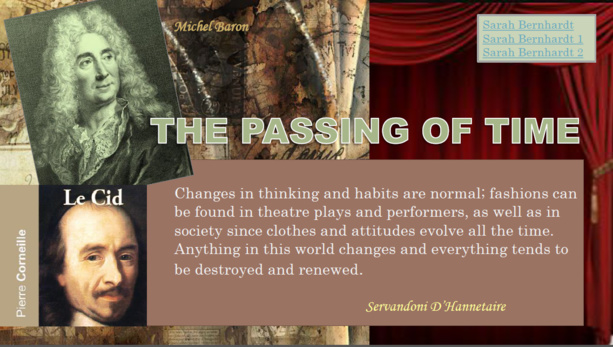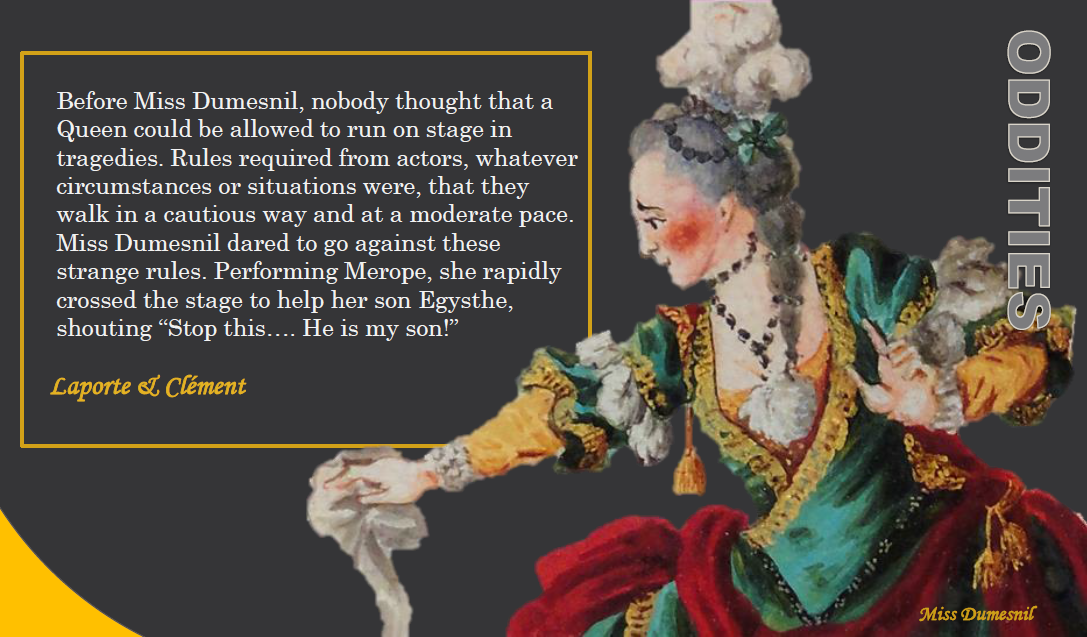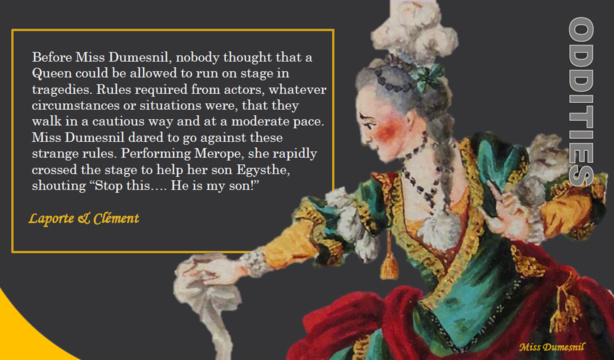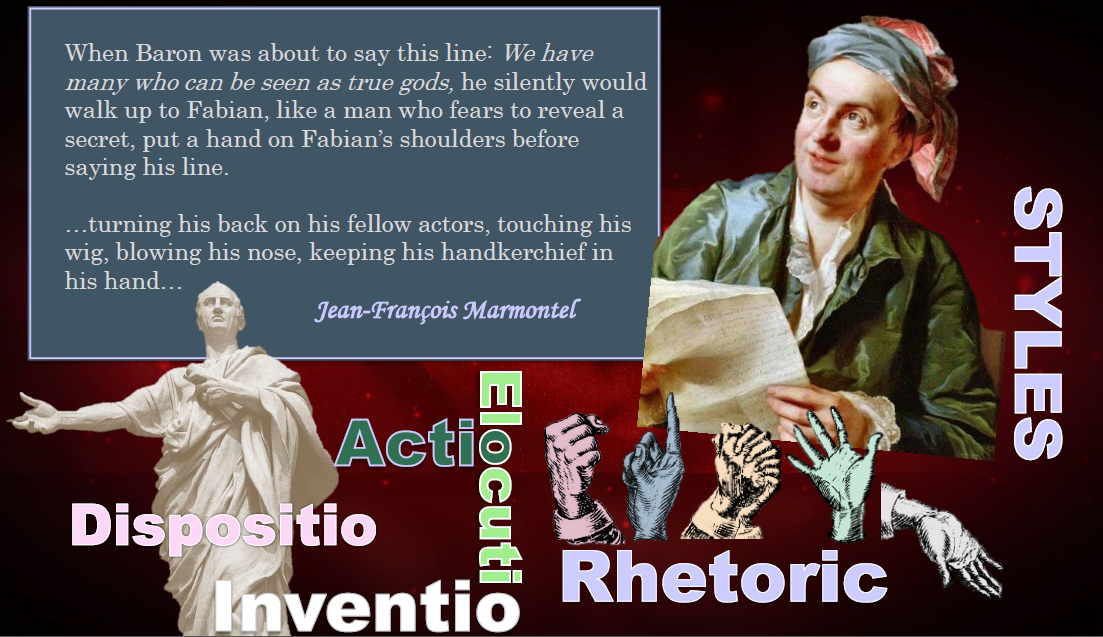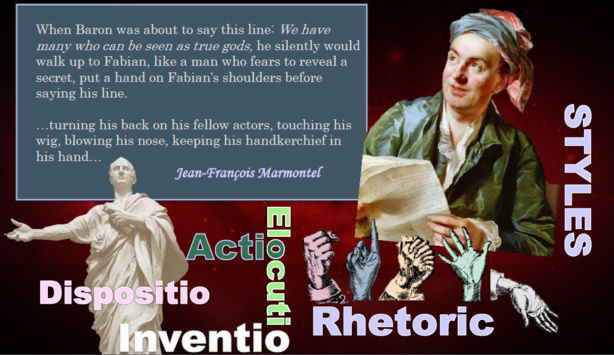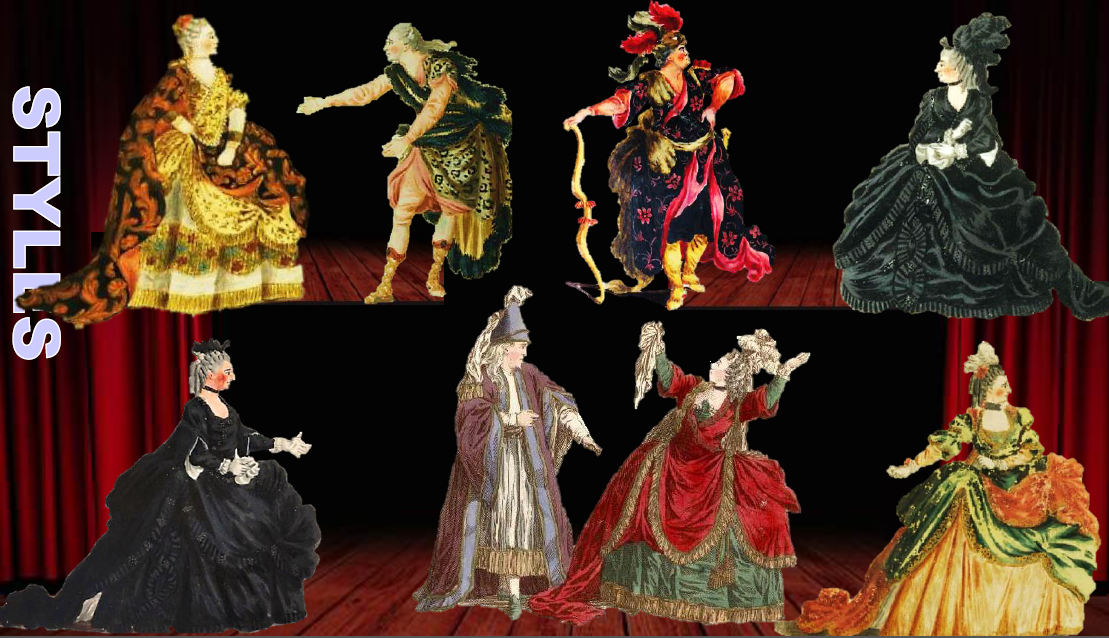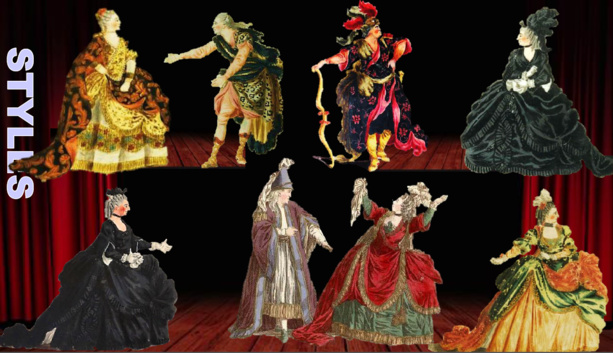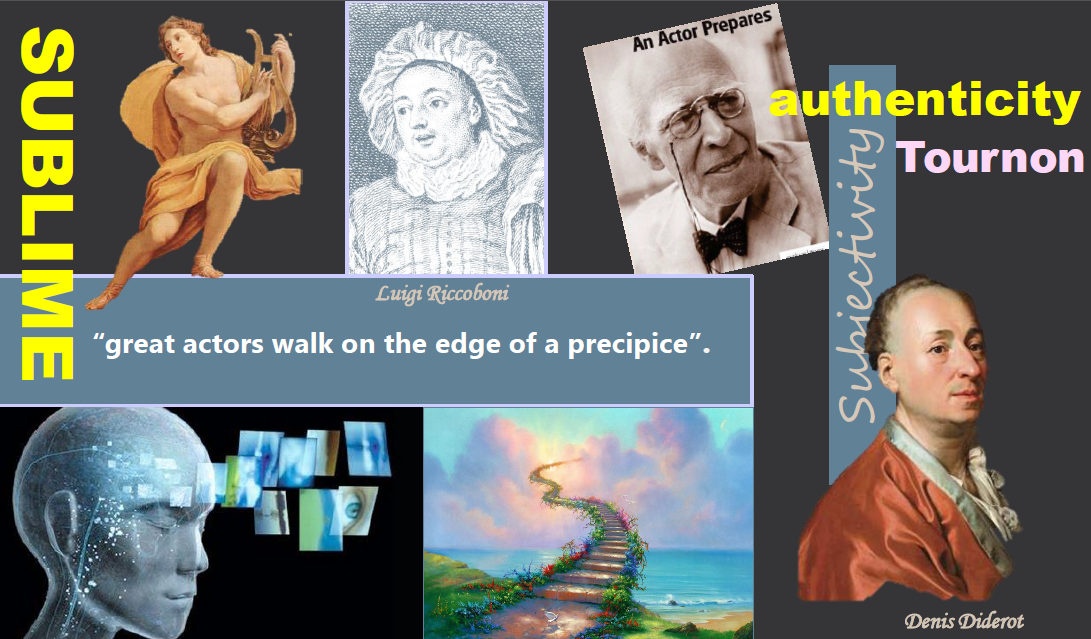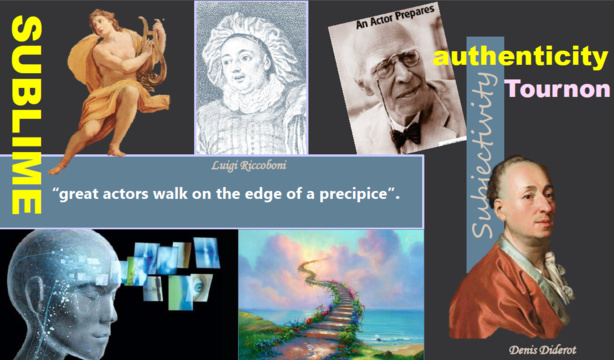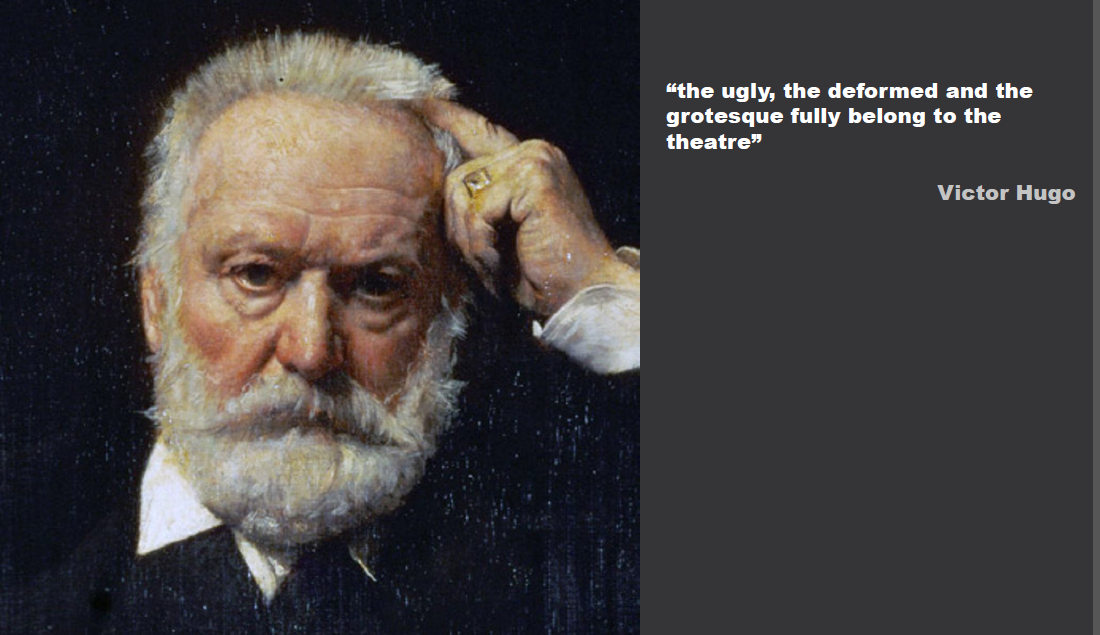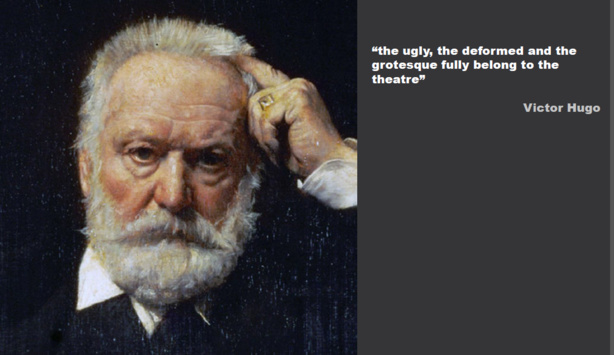Abstract
This paper examines “poor taste” in performance and its relationship to creative processes. It questions how poor taste was understood during the early modern period; what it consisted of and whether it had virtuous effects or not on the performing arts; and finally it assesses the way in which audiences responded to performers who deliberately went against established theatrical rules and traditions. It claims that audiences enjoyed “bad” acting, and thus that technique or social norms were not the sole or the main criteria to define and identify a “good actor”: sublime acting based on impulse gestures and emotions which were a sign of genius could have a stronger impact on audiences. Controversies on the actor’s talent and “taste” in performance were the first stage in a debate on the concept of the actor as creator, which regularly reignited up until the twentieth century and which culminated with Stanislavski’s theory and the Method of the Actor’s Studio.
In The Farewell of Taste, an allegorical comedy performed at the Comédie-Française in 1754, the main character Taste claims:
What have I just heard? What troubles were created by my absence?
Has Paris so often under my banners,
Disobeyed me?
And is only showing me
Evil decadence
Both of the Arts and Talents!
Has Fake Taste, this rival so loved by the Provinces
Seduced my dear favourites;
Are there no longer any places under my control? (1)
Poor taste, which is viewed as a provincial matter, influences the French capital. Hence the absence of Taste ― and poor taste ― has a negative impact on performance since actors and plays are no longer based on theatrical traditions and rules. Taste comes back therefore to Paris with a view to reinstating order within playhouses and restoring high-quality standards in acting. According to Momus the god of laughter who symbolizes new forms of comic, such endeavours are to no avail. Henceforth, Parisian audiences favour changes and unruliness, rejecting affectation, bombastic declamation, and old ways of acting that seem too common not to say entirely out of fashion. Momus lets Taste know that new aesthetics based on sensitivity rather than reason is in vogue, combining different theatrical genres and performing styles.
What have I just heard? What troubles were created by my absence?
Has Paris so often under my banners,
Disobeyed me?
And is only showing me
Evil decadence
Both of the Arts and Talents!
Has Fake Taste, this rival so loved by the Provinces
Seduced my dear favourites;
Are there no longer any places under my control? (1)
Poor taste, which is viewed as a provincial matter, influences the French capital. Hence the absence of Taste ― and poor taste ― has a negative impact on performance since actors and plays are no longer based on theatrical traditions and rules. Taste comes back therefore to Paris with a view to reinstating order within playhouses and restoring high-quality standards in acting. According to Momus the god of laughter who symbolizes new forms of comic, such endeavours are to no avail. Henceforth, Parisian audiences favour changes and unruliness, rejecting affectation, bombastic declamation, and old ways of acting that seem too common not to say entirely out of fashion. Momus lets Taste know that new aesthetics based on sensitivity rather than reason is in vogue, combining different theatrical genres and performing styles.
In his essay Le Goût Italien dans la France Rocaille, ca 1680-1715 published in 2011, François Moureau showed how this new “rococo style” influenced all the arts from the 1680s onwards, but in particular, theatre. Playwrights and troupes tried to accommodate audiences’ thirst for novelty and to anticipate changing tastes by creating new commercial shows such as the “dancourades” including music, dance, songs and more natural acting. The end of the seventeenth century coincides with evolving performance practices. This explains partly why many books on acting and performance were published over the following decades. Authors became more interested in what was good acting and what defined a beautiful performance, as well as in the evolution of acting through the ages, especially its core principles. By scrutinizing actors of their time, and their sudden popularity, they came to realize that controversies related mainly to unusual ways of performing. Taste and acting were intertwined because an actor’s fame mainly depended on the relationship between spectators and actors.
Yet for a researcher, when it comes to analysing acting, the notion of taste is problematic. Indeed, this word had different meanings during the period, being understood either as theatrical common practices or proprieties; as the actor’s intelligence that is to say his ability to understand his lines; or as a trend, success depending on fashion and audiences’ reaction to performances. In Early Modern Europe, acting was therefore seen as a “tasteful art” aiming to follow contemporary fashion trends. Jean-Nicolas Servandoni d’Hannetaire wrote for instance that actors were people devoted to audiences and voluntarily sacrificed themselves to Taste. (2) Taste in the theatre can be therefore analysed as a phenomenon, reflecting cultural and sociological patterns and evolutions, impacting directly on seasonal programmes and performances since acting had to adapt to demand.
In this paper I will focus on actors who symbolized ‘poor taste’, that is to say on those who seemed unable to perform in a coherent and graceful manner, and thus who could not differentiate unruly acting from professional acting. Beautiful imitations of nature were essential during the period, theatrical aesthetics prioritizing embellishment: actors had to improve both the text and stage by performing in a perfect way. These aspects raise the following questions which can apply to different periods:
• Can it be claimed that ‘bad’ acting should always be associated with poor performance and that actors did not train or rehearse enough?
• Should poor acting necessarily be seen as evidence of the actor’s ‘poor taste’ or on the contrary, the audience’s ‘poor taste’?
• Is there one poor taste only or multiple poor tastes which can be identified through criteria such as inadequate style, inability to answer audiences’ expectations or to master theatrical rules?
• Hence, should acting be analysed and evaluated without taking into consideration audiences since spectators could fancy poor acting styles? If theatrical rules are pivotal, how important is genius in this context?
To answer these questions and show how acting which was perceived as ‘bad’ can paradoxically reveal actors at the forefront of creativity, it is necessary to assess the impact of time over acting; the role played by unexpected or odd acting and by new styles which broke rhetorical rules; and finally to examine how the concept of the sublime became predominant in the eighteenth century and influenced European acting theories, up until the twentieth century.
In this paper I will focus on actors who symbolized ‘poor taste’, that is to say on those who seemed unable to perform in a coherent and graceful manner, and thus who could not differentiate unruly acting from professional acting. Beautiful imitations of nature were essential during the period, theatrical aesthetics prioritizing embellishment: actors had to improve both the text and stage by performing in a perfect way. These aspects raise the following questions which can apply to different periods:
• Can it be claimed that ‘bad’ acting should always be associated with poor performance and that actors did not train or rehearse enough?
• Should poor acting necessarily be seen as evidence of the actor’s ‘poor taste’ or on the contrary, the audience’s ‘poor taste’?
• Is there one poor taste only or multiple poor tastes which can be identified through criteria such as inadequate style, inability to answer audiences’ expectations or to master theatrical rules?
• Hence, should acting be analysed and evaluated without taking into consideration audiences since spectators could fancy poor acting styles? If theatrical rules are pivotal, how important is genius in this context?
To answer these questions and show how acting which was perceived as ‘bad’ can paradoxically reveal actors at the forefront of creativity, it is necessary to assess the impact of time over acting; the role played by unexpected or odd acting and by new styles which broke rhetorical rules; and finally to examine how the concept of the sublime became predominant in the eighteenth century and influenced European acting theories, up until the twentieth century.
‘EVERY GENERATION LAUGHS AT THE OLD FASHIONS, BUT FOLLOWS RELIGIOUSLY THE NEW’ (HENRY THOREAU)
Gustave Flaubert claimed in the Victorian era that bad taste is linked to and symbolizes what is left behind us. Time and temporal distance are therefore pivotal since they led to estrangement phenomena, old acting being gradually rejected and sometimes seen as ludicrous.
(Sarah Bernardht a more recent example:
example 1 (gestures)
example 2 (declamation).
This idea was expressed in the second part of the eighteenth century by D’Hannetaire who was actor and director of the Theatre de la Monnaie in Brussels:
Changes in thinking and habits are normal; fashions can be found in theatre plays and performers, as well as in society since clothes and attitudes evolve all the time. Anything in this world changes and everything tends to be destroyed and renewed. (3)
Acting has therefore its own life cycle. Poor taste seems to be the result of the passing the time, as if Beauty is ephemeral and temporary. Hence after a while beautiful acting becomes ugly, losing its main qualities and, in a way its magical effect on the audience. It is, therefore, crucial, according to D’Hannetaire to live with one’s time and be flexible. Actors have constantly to adapt to changing times if they want to remain popular and admired by their audiences. It is precisely this inability to follow and manage changes which was an issue at the Comédie-Française. Actors very often were reproached for their reactionary acting. The fairground theatres in particular staged parodies mocking tragic actors’ lack of innovation and creativity, as well as their old fashioned costumes, and unnatural declamation.
Time changes norms. In this sense, researchers have to pay attention to historical contexts when analysing acting and staging whatever the period may be. For instance, up until the 1720s, the age of the actor was never an issue. Young characters were performed by actors who were in their 50s and even 60s such as Baron who played the young lover Rodrigue in Pierre Corneille’s El Cid. However, old actors who paid their respects to teenage female lovers and characters, by kneeling in front of them and then had to be helped up by two stage hands became unacceptable, audiences craving for more realism and credibility in acting. As D’Hannetaire stressed, audiences shaped acting and could help improve it. In this context, taste was part of acting, and as such, performances were more and more understood as an interactive process and a living art, and not just a text.
(Sarah Bernardht a more recent example:
example 1 (gestures)
example 2 (declamation).
This idea was expressed in the second part of the eighteenth century by D’Hannetaire who was actor and director of the Theatre de la Monnaie in Brussels:
Changes in thinking and habits are normal; fashions can be found in theatre plays and performers, as well as in society since clothes and attitudes evolve all the time. Anything in this world changes and everything tends to be destroyed and renewed. (3)
Acting has therefore its own life cycle. Poor taste seems to be the result of the passing the time, as if Beauty is ephemeral and temporary. Hence after a while beautiful acting becomes ugly, losing its main qualities and, in a way its magical effect on the audience. It is, therefore, crucial, according to D’Hannetaire to live with one’s time and be flexible. Actors have constantly to adapt to changing times if they want to remain popular and admired by their audiences. It is precisely this inability to follow and manage changes which was an issue at the Comédie-Française. Actors very often were reproached for their reactionary acting. The fairground theatres in particular staged parodies mocking tragic actors’ lack of innovation and creativity, as well as their old fashioned costumes, and unnatural declamation.
Time changes norms. In this sense, researchers have to pay attention to historical contexts when analysing acting and staging whatever the period may be. For instance, up until the 1720s, the age of the actor was never an issue. Young characters were performed by actors who were in their 50s and even 60s such as Baron who played the young lover Rodrigue in Pierre Corneille’s El Cid. However, old actors who paid their respects to teenage female lovers and characters, by kneeling in front of them and then had to be helped up by two stage hands became unacceptable, audiences craving for more realism and credibility in acting. As D’Hannetaire stressed, audiences shaped acting and could help improve it. In this context, taste was part of acting, and as such, performances were more and more understood as an interactive process and a living art, and not just a text.
CHARMING ODDITIES
Successful actors distinguished themselves by having different styles such as Baron who was said to “speak” tragedy. On the contrary, Beaubourg shouted his lines uniformly and monotonously, and Miss Duclos “sang” hers in a melodic manner. New young rivals regularly showed up, bringing fresh acting and revolutionizing performance practices. The very nature of performance, that is to say, its phenomenological aspect, contrasted with the idea of intangible rules and absolute perfection though rehearsed acting. A history of acting styles can certainly be done but it proves difficult to claim that a unique form of ‘good’ acting prevailed, especially when the spirit of the times and audiences’ tastes which underpinned practices can never be fully grasped in its diachronic or synchronic dimensions. Moreover, D’Hannetaire showed that famous actors were not necessarily those who followed the rules:
This one who seemed a prodigy perhaps did not deserve such enthusiasm. Actors often show up on stage, performing with arrogance and impudence; they suddenly have their moment and in a matter of a few seconds earn admiration from the audience, by acting in a surprising, unrehearsed or spectacular way, often inspired by celebrities. Men, women, indeed everybody think it is a miracle and instantly claim that they are “divine actors”, that their voice, gestures, and movements, in short, everything is wonderfully performed, superbly understood; they are crowned and placed between Thalia and Melpomene by their admirers. The old actors, men or women, are disregarded and seen as dull. (4)
Surprisingly, actors who were not necessarily talented or brilliant could revolutionize acting and become a symbol of avant-garde. Poor taste proved to be in this case “unforgettable”. To make history actors had to break the rules and traditions. The following dramatic anecdote relating to Miss Dumesnil who belonged to the French Royal company in the 1740s shows that shocking and provoking audiences by ground-breaking acting helped modernize the performing arts:
Before Miss Dumesnil, nobody thought that a Queen could be allowed to run on stage in tragedies. Rules required from actors, whatever circumstances or situations were, that they walk in a cautious way and at a moderate pace. Miss Dumesnil dared to go against these strange rules. Performing Merope, she rapidly crossed the stage to help her son Egysthe, shouting “Stop this…. He is my son!” (6)
The adjective “strange” that is to say what is not sensible or common, suggests that rhetoric codes which were predominant in the seventeenth century were no longer understood by the man who related the anecdote whose ironic tone appears quite obvious. Innovation, of course, means going “out of the box”, and thus conflicting with prevailing good tastes. It is deeply correlated to the audience’s reactions:
Audiences were nevertheless happy with affected acting or extravagant acting; as they are nowadays with those who similarly exaggerate; although these are now famous, are they really good actors and can we reproach audiences for seeking pleasure in performances and having bad taste? (7)
The more tastes proved to be degenerate, the more they led to radical changes in norms and codes, reinvigorating and energising the performing arts. On the one hand, some actors, whose taste was not yet fully developed, did not hesitate to make an impression of celebrities’ acting style ―even if their imitation remained unsatisfactory― since singularity and oddity were generally approved by audiences. On the other hand, arrogant actors of the avant-garde who feared to displease and disappoint their admirers were tempted by immoderate gasps and hysterical gestures, good acting becoming bad acting:
Yet, what seems at first glance to be perfect acting often degenerates afterwards. Actors compete with their rivals or try to elaborate more sophisticated ways of acting; as a result excesses predominate especially because oddities are praised by the audience; Art becomes unnatural, good acting becomes bad acting; but audiences gradually get used to bad taste and think it is good taste and the norm; as a consequence, shows are perverted and corrupted by falsehood; unfortunately nothing can be done until this fanatic craze goes out of fashion. (8)
Taste is alternatively good or bad, and based on interactions between actors and audiences. Eclectic and heterogeneous acting styles reflect audiences’ own inhomogeneous tastes and versatile and impulse feelings that most often lead actors to become inauthentic and unprofessional. An art which would have no rules would no longer be an art therefore taste, as such, challenged the idea of art in performance since actors’ objectives could be limited to pleasing audiences. According to D’Hannetaire, actors had to find a balance between following strictly too many complicated rules which led to artificial and inauthentic acting, and rejecting any rules and training, which led to exaggeration and extravagance. Dorfeuille, in his work entitled Les Eléments de l’art du comédien, argued therefore at the end of the eighteenth century that the actor’s taste had to be disciplined and educated. “Natural” or “unsophisticated” taste remained imperfect: it explains why experienced actors, who used to mentor junior actors, argued that schools and training were essential. (9) However, the first School of Declamation was not opened until the 1770s in Compiegne near Paris.
This one who seemed a prodigy perhaps did not deserve such enthusiasm. Actors often show up on stage, performing with arrogance and impudence; they suddenly have their moment and in a matter of a few seconds earn admiration from the audience, by acting in a surprising, unrehearsed or spectacular way, often inspired by celebrities. Men, women, indeed everybody think it is a miracle and instantly claim that they are “divine actors”, that their voice, gestures, and movements, in short, everything is wonderfully performed, superbly understood; they are crowned and placed between Thalia and Melpomene by their admirers. The old actors, men or women, are disregarded and seen as dull. (4)
Surprisingly, actors who were not necessarily talented or brilliant could revolutionize acting and become a symbol of avant-garde. Poor taste proved to be in this case “unforgettable”. To make history actors had to break the rules and traditions. The following dramatic anecdote relating to Miss Dumesnil who belonged to the French Royal company in the 1740s shows that shocking and provoking audiences by ground-breaking acting helped modernize the performing arts:
Before Miss Dumesnil, nobody thought that a Queen could be allowed to run on stage in tragedies. Rules required from actors, whatever circumstances or situations were, that they walk in a cautious way and at a moderate pace. Miss Dumesnil dared to go against these strange rules. Performing Merope, she rapidly crossed the stage to help her son Egysthe, shouting “Stop this…. He is my son!” (6)
The adjective “strange” that is to say what is not sensible or common, suggests that rhetoric codes which were predominant in the seventeenth century were no longer understood by the man who related the anecdote whose ironic tone appears quite obvious. Innovation, of course, means going “out of the box”, and thus conflicting with prevailing good tastes. It is deeply correlated to the audience’s reactions:
Audiences were nevertheless happy with affected acting or extravagant acting; as they are nowadays with those who similarly exaggerate; although these are now famous, are they really good actors and can we reproach audiences for seeking pleasure in performances and having bad taste? (7)
The more tastes proved to be degenerate, the more they led to radical changes in norms and codes, reinvigorating and energising the performing arts. On the one hand, some actors, whose taste was not yet fully developed, did not hesitate to make an impression of celebrities’ acting style ―even if their imitation remained unsatisfactory― since singularity and oddity were generally approved by audiences. On the other hand, arrogant actors of the avant-garde who feared to displease and disappoint their admirers were tempted by immoderate gasps and hysterical gestures, good acting becoming bad acting:
Yet, what seems at first glance to be perfect acting often degenerates afterwards. Actors compete with their rivals or try to elaborate more sophisticated ways of acting; as a result excesses predominate especially because oddities are praised by the audience; Art becomes unnatural, good acting becomes bad acting; but audiences gradually get used to bad taste and think it is good taste and the norm; as a consequence, shows are perverted and corrupted by falsehood; unfortunately nothing can be done until this fanatic craze goes out of fashion. (8)
Taste is alternatively good or bad, and based on interactions between actors and audiences. Eclectic and heterogeneous acting styles reflect audiences’ own inhomogeneous tastes and versatile and impulse feelings that most often lead actors to become inauthentic and unprofessional. An art which would have no rules would no longer be an art therefore taste, as such, challenged the idea of art in performance since actors’ objectives could be limited to pleasing audiences. According to D’Hannetaire, actors had to find a balance between following strictly too many complicated rules which led to artificial and inauthentic acting, and rejecting any rules and training, which led to exaggeration and extravagance. Dorfeuille, in his work entitled Les Eléments de l’art du comédien, argued therefore at the end of the eighteenth century that the actor’s taste had to be disciplined and educated. “Natural” or “unsophisticated” taste remained imperfect: it explains why experienced actors, who used to mentor junior actors, argued that schools and training were essential. (9) However, the first School of Declamation was not opened until the 1770s in Compiegne near Paris.
FASHIONING UNIQUE STYLES
Sublime aesthetics that derived from the rococo vogue emerged at the end of the seventeenth century in Europe but did not impact on the performing arts until the 1720s. Baron and Miss Dumesnil symbolized new acting styles based on impulse and imperfection on stage, and the merger of different European traditions, especially French uncouth and vulgar farce, British emotionalism and “enthusiasm” as defined by Shaftesbury (Dionysian fury), and Italian improvisation and virtuosity.
Baron promoted such aesthetics by favouring uncontrolled gestures which were not necessarily graceful but authentic. He also championed the art of simplicity and contrasts. Two dramatic anecdotes give for example a glimpse of his peculiar acting style:
In the fourth act of Polyeucte, Sévère, discovering God’s unity, shares his views and doubts on profane religions which tolerate several Gods. When Baron was about to say this line: We have many who can be seen as true gods, he silently would walk up to Fabian, like a man who fears to reveal a secret, put a hand on Fabian’s shoulders before saying his line. Actors used to gesticulate in this scene. It explains why Baron’s gestures were first seen as too familiar. However, by this means, Baron showed the audience that his style was unique and that his acting was far better than his colleagues. (10)
Criticisms focused on Baron’s bad habits when he was on stage such as turning his back on his fellow actors, touching his wig, blowing his nose, keeping his handkerchief in his hand, especially in tragedies and other types of indecent actions. And yet he knew he was so graceful and brilliant that he never bothered to change his acting style. (11)
Baron developed more intuitive acting avoiding emphasis and taking advantage of silences as a means to impress the audience and create a more realistic character. The rules of actio were not adapted for the stage. The precepts of rhetoric, inspired mainly by Cicero and Quintilian, had been devised for orators (lawyers), that is to say for official, moral, or legal ‘speeches’ presented as ‘monologues’ without reference to theatrical situations, especially tragic ones, and moreover, with no interlocutors.
Rhetorical techniques were over-valued. The adage ‘an orator is not born but made’ was a key principle suggesting that actors had to master first codified gestures such as clenching fits to express anger and vocal rules in relation to passions, specific words and parts of speech. Hence, when Grimarest wrote the first book combining actio and declamation (1707), he invited actors to focus on the technique of performance and essentially on their appearance (12). Rhetorical rules did not allow free movement, free inspiration or improvisation in the acting of a part (13).
Physical signs brought on by passions were analysed and described from an external point of view by rhetoricians for their impact on the body and not the cause or origin of the passion on it. They were described in a simple way: one passion at a time, rather than a mixture of different passions fighting against each other or inter-dependent. Actors had therefore to reproduce them but not necessarily feel them. Furthermore, dramatic art encouraged actors to play their role as an image, in other words to be a simple copy of the character, in a mathematical way, selecting prior to the performance different attitudes in relation to the age, the gender, the feelings and the rank of the character in accordance with social conventions (‘bienséances’) and the precepts developed by Horatius in Art Poetica.
Rhetorical traditions were at the heart of a mechanical and artificial theatrical system. Most of the works published during the period listed mandatory rules and precise positions and movements. One of the main points of the art of silent eloquence was to focus the attention of the audience on the upper part of the body from head to waist. The rules were extremely strict. Orators had to avoid using their left hand. Gestures above the head or below the stomach were not tolerated. Neither were immoderate movements. On the contrary, dignity and majesty were required. Gestures and movements would stop at the end of each sentence or speech. They were designed to be didactic. They had to help the audience understand words and sentences and give a visual representation of what was being said as well as the characters’ emotions. Moreover, improvisation was banned as well as pure mimics or mime. Thus in the eighteenth century, Prince Charles Joseph de Ligne was still recommending that: “actors should not imitate the dragon with its crooked back, nor should they mime the receding tide.” (14) Besides, in 1764 D’Hannetaire not only forbade actors to “follow the ridiculous Italian style”, that is to say, mime but he also encouraged them to reject any symbolic gesture where “sensitivity was expressed by simply putting one hand on the chest”. To point to the heart was not a good way to express and perform emotions. From then on, this acting style was seen as puerile and unbearable, that is to say poor taste. (15) In addition, the aesthetics of the ‘Honnête-homme’/gentleman gave actors ethical rules which were based on an ideal of gravity and modesty, temperance and moderation, where emotions and feelings had to be carefully hidden and strongly controlled. In acting tragedy, the genre which was the closest to actio, the perception of a necessary dignity in such a character as the king/queen or the prince/princess influenced acting. Actors could easily avoid working the inner aspect of the role. They could simply show a ‘neutral stance’ as their character had to be ‘royal’, therefore reflecting sobriety.
Thinkers or rhetoricians of the seventeenth century never seemed to take heed of the importance of silence, as Baron did, and withholding of emotion in actio. Most thinkers believed that a certain majesty was sufficient. By scrupulously observing these ethical and rhetorical codes, actors were not involved in their role at all. The distance between the part and the self was too big and was transformed into indifference. They condemned the obvious inefficiency of the stage because of actors who just were reciting their lines, gazing at the audience after delivering their speech, and clearly showing a lack of interest in the scene in which they were involved as a character. It explains why, though the rules of actio were a model, various authors were scandalized by actors who were not really acting their part. New emerging acting styles being more natural and based on everyday life gestures, were gradually seen as “good” and acting influenced by rhetoric became a symbol of bad taste and archaism.
Baron promoted such aesthetics by favouring uncontrolled gestures which were not necessarily graceful but authentic. He also championed the art of simplicity and contrasts. Two dramatic anecdotes give for example a glimpse of his peculiar acting style:
In the fourth act of Polyeucte, Sévère, discovering God’s unity, shares his views and doubts on profane religions which tolerate several Gods. When Baron was about to say this line: We have many who can be seen as true gods, he silently would walk up to Fabian, like a man who fears to reveal a secret, put a hand on Fabian’s shoulders before saying his line. Actors used to gesticulate in this scene. It explains why Baron’s gestures were first seen as too familiar. However, by this means, Baron showed the audience that his style was unique and that his acting was far better than his colleagues. (10)
Criticisms focused on Baron’s bad habits when he was on stage such as turning his back on his fellow actors, touching his wig, blowing his nose, keeping his handkerchief in his hand, especially in tragedies and other types of indecent actions. And yet he knew he was so graceful and brilliant that he never bothered to change his acting style. (11)
Baron developed more intuitive acting avoiding emphasis and taking advantage of silences as a means to impress the audience and create a more realistic character. The rules of actio were not adapted for the stage. The precepts of rhetoric, inspired mainly by Cicero and Quintilian, had been devised for orators (lawyers), that is to say for official, moral, or legal ‘speeches’ presented as ‘monologues’ without reference to theatrical situations, especially tragic ones, and moreover, with no interlocutors.
Rhetorical techniques were over-valued. The adage ‘an orator is not born but made’ was a key principle suggesting that actors had to master first codified gestures such as clenching fits to express anger and vocal rules in relation to passions, specific words and parts of speech. Hence, when Grimarest wrote the first book combining actio and declamation (1707), he invited actors to focus on the technique of performance and essentially on their appearance (12). Rhetorical rules did not allow free movement, free inspiration or improvisation in the acting of a part (13).
Physical signs brought on by passions were analysed and described from an external point of view by rhetoricians for their impact on the body and not the cause or origin of the passion on it. They were described in a simple way: one passion at a time, rather than a mixture of different passions fighting against each other or inter-dependent. Actors had therefore to reproduce them but not necessarily feel them. Furthermore, dramatic art encouraged actors to play their role as an image, in other words to be a simple copy of the character, in a mathematical way, selecting prior to the performance different attitudes in relation to the age, the gender, the feelings and the rank of the character in accordance with social conventions (‘bienséances’) and the precepts developed by Horatius in Art Poetica.
Rhetorical traditions were at the heart of a mechanical and artificial theatrical system. Most of the works published during the period listed mandatory rules and precise positions and movements. One of the main points of the art of silent eloquence was to focus the attention of the audience on the upper part of the body from head to waist. The rules were extremely strict. Orators had to avoid using their left hand. Gestures above the head or below the stomach were not tolerated. Neither were immoderate movements. On the contrary, dignity and majesty were required. Gestures and movements would stop at the end of each sentence or speech. They were designed to be didactic. They had to help the audience understand words and sentences and give a visual representation of what was being said as well as the characters’ emotions. Moreover, improvisation was banned as well as pure mimics or mime. Thus in the eighteenth century, Prince Charles Joseph de Ligne was still recommending that: “actors should not imitate the dragon with its crooked back, nor should they mime the receding tide.” (14) Besides, in 1764 D’Hannetaire not only forbade actors to “follow the ridiculous Italian style”, that is to say, mime but he also encouraged them to reject any symbolic gesture where “sensitivity was expressed by simply putting one hand on the chest”. To point to the heart was not a good way to express and perform emotions. From then on, this acting style was seen as puerile and unbearable, that is to say poor taste. (15) In addition, the aesthetics of the ‘Honnête-homme’/gentleman gave actors ethical rules which were based on an ideal of gravity and modesty, temperance and moderation, where emotions and feelings had to be carefully hidden and strongly controlled. In acting tragedy, the genre which was the closest to actio, the perception of a necessary dignity in such a character as the king/queen or the prince/princess influenced acting. Actors could easily avoid working the inner aspect of the role. They could simply show a ‘neutral stance’ as their character had to be ‘royal’, therefore reflecting sobriety.
Thinkers or rhetoricians of the seventeenth century never seemed to take heed of the importance of silence, as Baron did, and withholding of emotion in actio. Most thinkers believed that a certain majesty was sufficient. By scrupulously observing these ethical and rhetorical codes, actors were not involved in their role at all. The distance between the part and the self was too big and was transformed into indifference. They condemned the obvious inefficiency of the stage because of actors who just were reciting their lines, gazing at the audience after delivering their speech, and clearly showing a lack of interest in the scene in which they were involved as a character. It explains why, though the rules of actio were a model, various authors were scandalized by actors who were not really acting their part. New emerging acting styles being more natural and based on everyday life gestures, were gradually seen as “good” and acting influenced by rhetoric became a symbol of bad taste and archaism.
FROM POOR TASTE TO MODERN AESTHETICS
As I showed in my books entitled L’Art du comédien and La Philosophie de l’Acteur which dealt with acting and the philosophy of performance, the use of gestures aiming to embody passions rather than actually be the manifestations of passions through the body was rejected in the eighteenth century. Baron’s innovations led the way. The actor clearly fashioned new movements and gestures, contesting what “good taste” was in the 1720s and offering a new version of it. In the 1740s, Miss Dumesnil did the same. According to Laporte the tragic actor was able to rapidly change her acting style during a performance. She could make the audience laugh and then suddenly cry; in a tragic scene, she could act as Pompée’s widow or as George Dandin’s servant. (16) Audiences enjoyed this new mix of theatrical genres within the same performance. Miss Dumesnil was alternatively sublime or grotesque. In that sense, her acting style could be compared with Shakespearian plays, combining comic, grotesque and tragic elements, although those were not translated by Ducis in France until the 1770s. This way of acting was pioneering and the first steps towards melodramatic and romantic acting. Being trivial, lacking manners and expressing emotions without taking into consideration the old rules was part of new experiments to modernise acting. As Luigi Riccoboni argued in the first part of the eighteenth century, “great actors walk on the edge of a precipice”. (17) They had to take risks and be audacious. This relationship to their art therefore required an element of freedom which was directly linked to the actor’s creativity ― and not just ‘poor taste’.
It was not until the middle of the eighteenth century that theorists began to invoke inner qualities. Luigi Riccoboni (1738), who had experience which neither the audience nor the philosophers could have, was the first actor to publish an essay about the interpretation of a role in front of members of the audience. Pensées sur la déclamation explore in what way actors can build a character during the performance. They have to create an inner illusion which is similar in form to delusion. (18) Riccoboni argued that actors had to connect to God, as Poets did when they were inspired by Muses. The image of ‘furor’ and ‘enthusiasm’ was derived from traditional myths which had been promoted in the sixteenth century by the Pléiade (apollonian poetic furor) and perpetuated in the classical period, and more recent ideas about the sublime expressed by Shaftesbury.
But this idea was not the most interesting in his conception of the Actor. Asserting that the actor was unable to perceive exteriority and reality, such as the members of the audience, the auditorium or the stage when he was focused on the present moment and the scenic situation in which he played a part, Riccoboni suggested that performing meant being in a certain physical state and moreover in a certain state of consciousness which implied the animation of all the elements composing the ‘mental being’: imagination, sensibility, and sensitivity. The actor needed an inner ‘availability’ to enter (being) completely into his role that was at the heart of authenticity. The modification of consciousness meant forgetting real time and moving in one’s own world of imagination, creating in there the character and bringing it to life. The actor focused, not on who he was (that is to say his identity), but on what he was doing; he could then transfer his own abilities and creativity directly into and onto the role. (19) Such inner creative process guaranteed originality. Unexpected and unfamiliar acting was a key to avant-garde.
Riccoboni asserted then that the involvement in the ‘temporality’ of the performance (the play) and the concentration on the present event created a sort of spontaneous acting. Objectivity, that is to say the World, Reality, was deleted in favour of Subjectivity and Imagination. The force of enthusiasm was so strong that the actor entered into a sort of secondary state. He would speak his lines without necessarily needing to remember them or preparing in advance in his mind what he had to say to his fellow actors. His perception of time and space was, in a way, obliterated. Riccoboni’s suggestions were particularly relevant but quite classical in his assumption that an external entity inspired the soul (enthusiasm < enthusiasmos, being linked with God in a ‘ravissement’ and, in the seventeenth century, being impelled to act with joy).
His views were taken further by Tournon in L’Art du comédien vu dans ses principes, in 1782, (20) an essay which was fundamental to the history of the theory of acting, and in a way, more ground-breaking than the famous Paradoxe sur le comédien by Diderot which was not published until 1830 anyway. Tournon abandoned the idea of ‘enthusiasm’ for ‘inner illusion’. Distancing himself from the Italian actor, Tournon invented the concept of ‘inner illusion’ in an innovative way: suggesting also that the actor voluntarily operated a transformation of his state of consciousness; he showed that ‘inner’ mental movements created a dynamic of physical effects, that is to say a sort of causal chain. The excellent actor was not transcended by a sacred entity such as God, or even by a delusion. He had the power of creation because he was able to modify his mind intentionally in order to enter into the role. In concrete terms, this meant he had in fact to transfer his own inner qualities onto the part in order, not to be identical – a copy of the role, though still distinct ― but identified with it by a creative inner fusion with the role. The first movement in the creation of the character was not exteriorization. The actor had primarily to integrate the ‘character’ into his being in order to transform it into his own character, by appropriation. A harmony had to be maintained between sensitivity and sensibility, feelings and mind. But consequently, from the existence of this link between ‘heart’ and ‘reason’, there emerged an unconventional form of acting as the inner side gave the actor his own style, his ‘own accent’. In that sense, the notion of taste could not be seen as criteria to define what a good actor was.
Moreover, Tournon’s views differed from Riccoboni’s because enthusiasm was not associated with a kind of madness (‘scenic furor’). Even if the actor was identifying with the role, he could still control his acting. The balance between reason and the heart gave rise on stage to what I called a ‘scenic sincerity’ because the outer side was fully synchronized with the inner side. The notion of natural acting which, since the seventeenth century, had been synonymous with a mechanical but scrupulous application of rules and traditions, of rhetoric codes, was rejected in favour of this new concept of ‘authenticity’ which quickly became a marker of modernity. Sincerity showed a perfect harmony between being and doing, between the inner and the outer which could be felt by the members of the audience as non-dissonant acting, thus ‘natural’ acting. Authenticity resulted from a synchronization between dramatic situation (the story of the play) and scenic situation (the performance, when and where the actor plays his part).
This conception of staging is really interesting. It offered freedom to the actor. He could make mistakes, he could forget a word or a gesture… it did not really matter: the Spectator often did not know the play or, if so, did not know the lines in full. The ‘impression’ of sincerity had a direct effect on illusion. The members of the audience could enter directly into the story because they did not feel the necessity to think about what they were seeing, whether it was poor or good taste. They instantly focused on the story rather than the actor’s art. The coordination between body language and declamation, their permanent unity, immediately gave to acting a ‘plausible’, totally ‘vraisemblable’ aspect which was more ‘persuasive’ than a mechanical and cold actor whose gestures were affected, because they were too studied. That is why Tournon distinguished actors from ‘comédiens’. The real actor did not imitate nature but followed it because he was completely absorbed by his action, by his own inner illusion. The conventional actor seemed cut off from life and thus without a soul, because he would think about what he had to do on stage: he looked for an ‘aesthetic’ style of acting. The diktat of rules helped increase the distance between the role and the actor on stage, when it should be eliminated: the actor could never be in the role and therefore he could never be the role. Thus he remained a ‘comédien’, someone simulating feelings. The modern meaning of acting was assimilated to a particular form of existence on stage which involved the commitment of the actor’s whole being as he immersed himself in the theatrical situation. Debates on artificial or sincere acting went on until the twentieth century and culminated with Stanislavski’s theory and the publication of his masterpiece An Actor Prepares, and the Method of the Actor’s Studio. Eighteenth century controversies on the actor’s talent in relation to good or poor taste and the notion of art were therefore the basis for modern acting. Sublime aesthetics remained indeed a symbol of avant-garde and modernity.
It was not until the middle of the eighteenth century that theorists began to invoke inner qualities. Luigi Riccoboni (1738), who had experience which neither the audience nor the philosophers could have, was the first actor to publish an essay about the interpretation of a role in front of members of the audience. Pensées sur la déclamation explore in what way actors can build a character during the performance. They have to create an inner illusion which is similar in form to delusion. (18) Riccoboni argued that actors had to connect to God, as Poets did when they were inspired by Muses. The image of ‘furor’ and ‘enthusiasm’ was derived from traditional myths which had been promoted in the sixteenth century by the Pléiade (apollonian poetic furor) and perpetuated in the classical period, and more recent ideas about the sublime expressed by Shaftesbury.
But this idea was not the most interesting in his conception of the Actor. Asserting that the actor was unable to perceive exteriority and reality, such as the members of the audience, the auditorium or the stage when he was focused on the present moment and the scenic situation in which he played a part, Riccoboni suggested that performing meant being in a certain physical state and moreover in a certain state of consciousness which implied the animation of all the elements composing the ‘mental being’: imagination, sensibility, and sensitivity. The actor needed an inner ‘availability’ to enter (being) completely into his role that was at the heart of authenticity. The modification of consciousness meant forgetting real time and moving in one’s own world of imagination, creating in there the character and bringing it to life. The actor focused, not on who he was (that is to say his identity), but on what he was doing; he could then transfer his own abilities and creativity directly into and onto the role. (19) Such inner creative process guaranteed originality. Unexpected and unfamiliar acting was a key to avant-garde.
Riccoboni asserted then that the involvement in the ‘temporality’ of the performance (the play) and the concentration on the present event created a sort of spontaneous acting. Objectivity, that is to say the World, Reality, was deleted in favour of Subjectivity and Imagination. The force of enthusiasm was so strong that the actor entered into a sort of secondary state. He would speak his lines without necessarily needing to remember them or preparing in advance in his mind what he had to say to his fellow actors. His perception of time and space was, in a way, obliterated. Riccoboni’s suggestions were particularly relevant but quite classical in his assumption that an external entity inspired the soul (enthusiasm < enthusiasmos, being linked with God in a ‘ravissement’ and, in the seventeenth century, being impelled to act with joy).
His views were taken further by Tournon in L’Art du comédien vu dans ses principes, in 1782, (20) an essay which was fundamental to the history of the theory of acting, and in a way, more ground-breaking than the famous Paradoxe sur le comédien by Diderot which was not published until 1830 anyway. Tournon abandoned the idea of ‘enthusiasm’ for ‘inner illusion’. Distancing himself from the Italian actor, Tournon invented the concept of ‘inner illusion’ in an innovative way: suggesting also that the actor voluntarily operated a transformation of his state of consciousness; he showed that ‘inner’ mental movements created a dynamic of physical effects, that is to say a sort of causal chain. The excellent actor was not transcended by a sacred entity such as God, or even by a delusion. He had the power of creation because he was able to modify his mind intentionally in order to enter into the role. In concrete terms, this meant he had in fact to transfer his own inner qualities onto the part in order, not to be identical – a copy of the role, though still distinct ― but identified with it by a creative inner fusion with the role. The first movement in the creation of the character was not exteriorization. The actor had primarily to integrate the ‘character’ into his being in order to transform it into his own character, by appropriation. A harmony had to be maintained between sensitivity and sensibility, feelings and mind. But consequently, from the existence of this link between ‘heart’ and ‘reason’, there emerged an unconventional form of acting as the inner side gave the actor his own style, his ‘own accent’. In that sense, the notion of taste could not be seen as criteria to define what a good actor was.
Moreover, Tournon’s views differed from Riccoboni’s because enthusiasm was not associated with a kind of madness (‘scenic furor’). Even if the actor was identifying with the role, he could still control his acting. The balance between reason and the heart gave rise on stage to what I called a ‘scenic sincerity’ because the outer side was fully synchronized with the inner side. The notion of natural acting which, since the seventeenth century, had been synonymous with a mechanical but scrupulous application of rules and traditions, of rhetoric codes, was rejected in favour of this new concept of ‘authenticity’ which quickly became a marker of modernity. Sincerity showed a perfect harmony between being and doing, between the inner and the outer which could be felt by the members of the audience as non-dissonant acting, thus ‘natural’ acting. Authenticity resulted from a synchronization between dramatic situation (the story of the play) and scenic situation (the performance, when and where the actor plays his part).
This conception of staging is really interesting. It offered freedom to the actor. He could make mistakes, he could forget a word or a gesture… it did not really matter: the Spectator often did not know the play or, if so, did not know the lines in full. The ‘impression’ of sincerity had a direct effect on illusion. The members of the audience could enter directly into the story because they did not feel the necessity to think about what they were seeing, whether it was poor or good taste. They instantly focused on the story rather than the actor’s art. The coordination between body language and declamation, their permanent unity, immediately gave to acting a ‘plausible’, totally ‘vraisemblable’ aspect which was more ‘persuasive’ than a mechanical and cold actor whose gestures were affected, because they were too studied. That is why Tournon distinguished actors from ‘comédiens’. The real actor did not imitate nature but followed it because he was completely absorbed by his action, by his own inner illusion. The conventional actor seemed cut off from life and thus without a soul, because he would think about what he had to do on stage: he looked for an ‘aesthetic’ style of acting. The diktat of rules helped increase the distance between the role and the actor on stage, when it should be eliminated: the actor could never be in the role and therefore he could never be the role. Thus he remained a ‘comédien’, someone simulating feelings. The modern meaning of acting was assimilated to a particular form of existence on stage which involved the commitment of the actor’s whole being as he immersed himself in the theatrical situation. Debates on artificial or sincere acting went on until the twentieth century and culminated with Stanislavski’s theory and the publication of his masterpiece An Actor Prepares, and the Method of the Actor’s Studio. Eighteenth century controversies on the actor’s talent in relation to good or poor taste and the notion of art were therefore the basis for modern acting. Sublime aesthetics remained indeed a symbol of avant-garde and modernity.
CONCLUSION
To conclude, debates on what good or poor taste was in terms of acting in eighteenth-century Europe reveal in fact the tensions between the aesthetics of the Sublime and the aesthetics of the Beautiful. It became a core component of modern acting. Too many rules had destroyed energy on stage. ‘Inspiration’ was gradually opposed to ‘machinations’ which symbolized only artificiality, and in a way, obsolescence because it was linked to the past. As we have shown, Miss Dumesnil, ‘forgetting’ the principles of traditional acting when she immersed herself in the scenic situation and not in what she had to perform, invented a new style. Her acting required instinctive movements and a liberation of emotions created in relation to the circumstances. For the thinkers of the Enlightenment primary forces were synonymous with Nature and authenticity.
The famous anecdote showing Miss Dumesnil’s running on stage made audiences and thinkers realize that the effect of ‘vraisemblance’/verisimilitude on stage should not be to comply with the rules of ‘bienséance’/decency but to direct one’s thoughts and feelings towards the present situation. The scene which was performed could not allow the actress to remain in a sort of rigid dignity, even if she was playing a noble and aristocratic role. The pressure of death was strong and imminent. She could not think or prepare, memorize or rehearse all her movements and intonations before performing because she would not be in the tempo of the performance. The expression of passions in a violent crisis helped create a palpitating rhythm and thus, lively characters. Respect for convenience and decency proved to be absurd in situations which needed interactivity and coordination between all the actors: gestures were the result of a projection of the inner being of each actor not only onto their role but also onto the performance. The violent and disordered expression of pathos that is to say passions became a priority on stage, whatever the social class of the character. In the Enlightenment, many famous actors championed a realistic spectacle of passions and emotions, having a more sensualist approach to performance. Baron claimed for instance that « Rules forbid to raise your arms and hands above your head; however, if passion leads them to do so, this will be good; passion is more important than rules” (reported by Marmontel).
Finally, provocative and transgressive acting, as well as new stage effects emphasizing blood and gore or spectacular staging, became very popular in the late eighteenth century. Hence the shift, from the mimesis concept, that is to say the imitation of nature and its embellishment, to the aesthetics of the Sublime and enthusiasm. This aesthetics was primarily seen as “poor taste” since it was based on “imperfection” and prosaic performance practices. It became visible through the craze for antagonistic and conflicting acting such as “sophisticated disorder”, “discordant harmony” or what we call “alternating acting”, that is to say the combination of traditional and rational acting based on rhetoric, and impulse and unruly acting.
This transitional period symbolizes the birth of the actor as artist and creator; an actor not depending on taste but being a taste-maker and showing his genius. Gradually ‘Poor taste’ was less related to dichotomist concepts such as the Beautiful or the Ugly. The adjective ‘poor’ in the context of the performing arts became irrelevant since singularity and originality were most often favoured by audiences and could not be part of any predefined category since it was associated with the “je ne sais quoi”. As Victor Hugo argued in the nineteenth century, “the ugly, the deformed and the grotesque fully belong to the theatre” (21).
The famous anecdote showing Miss Dumesnil’s running on stage made audiences and thinkers realize that the effect of ‘vraisemblance’/verisimilitude on stage should not be to comply with the rules of ‘bienséance’/decency but to direct one’s thoughts and feelings towards the present situation. The scene which was performed could not allow the actress to remain in a sort of rigid dignity, even if she was playing a noble and aristocratic role. The pressure of death was strong and imminent. She could not think or prepare, memorize or rehearse all her movements and intonations before performing because she would not be in the tempo of the performance. The expression of passions in a violent crisis helped create a palpitating rhythm and thus, lively characters. Respect for convenience and decency proved to be absurd in situations which needed interactivity and coordination between all the actors: gestures were the result of a projection of the inner being of each actor not only onto their role but also onto the performance. The violent and disordered expression of pathos that is to say passions became a priority on stage, whatever the social class of the character. In the Enlightenment, many famous actors championed a realistic spectacle of passions and emotions, having a more sensualist approach to performance. Baron claimed for instance that « Rules forbid to raise your arms and hands above your head; however, if passion leads them to do so, this will be good; passion is more important than rules” (reported by Marmontel).
Finally, provocative and transgressive acting, as well as new stage effects emphasizing blood and gore or spectacular staging, became very popular in the late eighteenth century. Hence the shift, from the mimesis concept, that is to say the imitation of nature and its embellishment, to the aesthetics of the Sublime and enthusiasm. This aesthetics was primarily seen as “poor taste” since it was based on “imperfection” and prosaic performance practices. It became visible through the craze for antagonistic and conflicting acting such as “sophisticated disorder”, “discordant harmony” or what we call “alternating acting”, that is to say the combination of traditional and rational acting based on rhetoric, and impulse and unruly acting.
This transitional period symbolizes the birth of the actor as artist and creator; an actor not depending on taste but being a taste-maker and showing his genius. Gradually ‘Poor taste’ was less related to dichotomist concepts such as the Beautiful or the Ugly. The adjective ‘poor’ in the context of the performing arts became irrelevant since singularity and originality were most often favoured by audiences and could not be part of any predefined category since it was associated with the “je ne sais quoi”. As Victor Hugo argued in the nineteenth century, “the ugly, the deformed and the grotesque fully belong to the theatre” (21).
NOTES
(1) Claude-Pierre Patu et Michel Portelance, Les Adieux du Goût, pièce en un acte représentée le mercredi 13 février 1754, Paris, s.n., 1754, sc. 1. Le nombre de pièces comportant le mot « goût » est assez limité. La base CESAR indique : Les Femmes à la mode ou le Goût du siècle (n/d), Le Rétablissement du bon goût et des beaux-arts (12 août 1716), Le Temple du goût (Romagnesi, Niveaux, 11 juillet 1733), Polichinelle dieu du goût (12 août 1733), Les Adieux du goût (Patu, Portelance, 13 février 1754), Le Retour du goût (Chevrier, 25 février 1754), Le Temple du goût (Dorat, n/d), Le Goût du siècle (Bouthillier, 1766), Le Jugement du bon goût (30 janvier 1782), La Mode et le goût (Mérey, 1771), Le Palais du bon goût (Guillemain, 1er janvier 1785), Chacun à son goût (1786), Les Folies du goût de Paris (16 juillet 1786).
(2) Jean-Nicolas Servandoni D’Hannetaire, Observations sur l’art du comédien, Paris, aux dépens d’une société typographique, [1764] 1774, p. xi-xii.
(3) D’Hannetaire, op. cit., p. 305.
(4) D’Hannetaire, ibid., p. 305-306.
(5) Dans Mérope de Voltaire (1743 / 1744), IV, 2.
(6) S. Chaouche, La Scène en contrechamp, Paris, Honoré Champion, 2005, p. 119-120.
(7) D’Hannetaire, op. cit., p. 309.
(8) D’Hannetaire, ibid, p. 318-319.
(9) Pierre Poupart dit Dorfeuille, Les Eléments de l’art du comédien, Paris, chez l’Imprimeur, An VII, chapitre goût, premier cahier, p. 21-22.
(10) Chaouche, op. cit., p. 126.
(11) Abbé d’Allainval, Lettre sur mylord et mademoiselle Lecouvreur, Paris, A. de Heuqueville, 1730, p. 11.
(12) Grimarest, Traité du récitatif, 1707, in Sept Traités sur le jeu du comédien de l’action oratoire à l’art dramatique, 1657-1750, ed. by S. Chaouche (Paris: Champion, 2001), p. 330.
(13) Sabine Chaouche, L’Art du comédien, Déclamation et jeu scénique en France à l’âge classique, 1629-1680 (Paris: Honoré Champion, 2001), first part.
(14) Prince de Ligne about Théramène : “il ne faut jouer ni le dragon à croupe recourbée, ni le flot qui recule” in Lettres à Eulalie, in Mélanges Littéraires, militaires et sentimentaires (Vienne, Dresde: Walther, 1696), letter 7.
(15) “Enfin j’ajouterai ici un dernier avis aux Gesticulateurs : c’est d’éviter, et de laisser aux Acteurs Italiens, cette puérile exactitude du geste à la chose, comme font la plupart de nos Comédiens qui, pour mieux exprimer, par exemple, la sensibilité du cœur ou autres passions de l’âme, ne manquent jamais de s’appliquer fortement la main sur la poitrine ; comme si effectivement il était question du cœur physique en cette occasion.” (Observations sur l’art du comédien (Paris: s.d., 1774), p. 207.
(16) Abbé Joseph de La Porte, Observations sur la Littérature moderne, La Haye, s.n., 1750, p. 242-243.
(17) Sept Traités sur le jeu du comédien,, op. cit., p. 499.
(18) Riccoboni, op. cit., p. 455.
(19) Riccoboni, op. cit., p. 493.
(20) Tournon, L’Art du comédien vu dans ses principes (Paris: Cailleau et Duchesne, 1782), pp. 58-59.
(21) Victor Hugo, Préface de Cromwell.
(2) Jean-Nicolas Servandoni D’Hannetaire, Observations sur l’art du comédien, Paris, aux dépens d’une société typographique, [1764] 1774, p. xi-xii.
(3) D’Hannetaire, op. cit., p. 305.
(4) D’Hannetaire, ibid., p. 305-306.
(5) Dans Mérope de Voltaire (1743 / 1744), IV, 2.
(6) S. Chaouche, La Scène en contrechamp, Paris, Honoré Champion, 2005, p. 119-120.
(7) D’Hannetaire, op. cit., p. 309.
(8) D’Hannetaire, ibid, p. 318-319.
(9) Pierre Poupart dit Dorfeuille, Les Eléments de l’art du comédien, Paris, chez l’Imprimeur, An VII, chapitre goût, premier cahier, p. 21-22.
(10) Chaouche, op. cit., p. 126.
(11) Abbé d’Allainval, Lettre sur mylord et mademoiselle Lecouvreur, Paris, A. de Heuqueville, 1730, p. 11.
(12) Grimarest, Traité du récitatif, 1707, in Sept Traités sur le jeu du comédien de l’action oratoire à l’art dramatique, 1657-1750, ed. by S. Chaouche (Paris: Champion, 2001), p. 330.
(13) Sabine Chaouche, L’Art du comédien, Déclamation et jeu scénique en France à l’âge classique, 1629-1680 (Paris: Honoré Champion, 2001), first part.
(14) Prince de Ligne about Théramène : “il ne faut jouer ni le dragon à croupe recourbée, ni le flot qui recule” in Lettres à Eulalie, in Mélanges Littéraires, militaires et sentimentaires (Vienne, Dresde: Walther, 1696), letter 7.
(15) “Enfin j’ajouterai ici un dernier avis aux Gesticulateurs : c’est d’éviter, et de laisser aux Acteurs Italiens, cette puérile exactitude du geste à la chose, comme font la plupart de nos Comédiens qui, pour mieux exprimer, par exemple, la sensibilité du cœur ou autres passions de l’âme, ne manquent jamais de s’appliquer fortement la main sur la poitrine ; comme si effectivement il était question du cœur physique en cette occasion.” (Observations sur l’art du comédien (Paris: s.d., 1774), p. 207.
(16) Abbé Joseph de La Porte, Observations sur la Littérature moderne, La Haye, s.n., 1750, p. 242-243.
(17) Sept Traités sur le jeu du comédien,, op. cit., p. 499.
(18) Riccoboni, op. cit., p. 455.
(19) Riccoboni, op. cit., p. 493.
(20) Tournon, L’Art du comédien vu dans ses principes (Paris: Cailleau et Duchesne, 1782), pp. 58-59.
(21) Victor Hugo, Préface de Cromwell.
